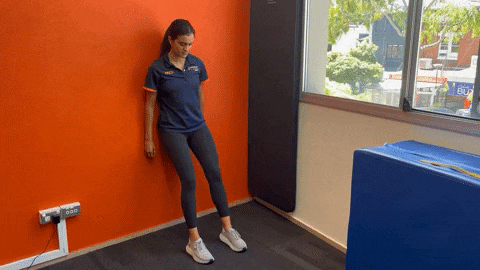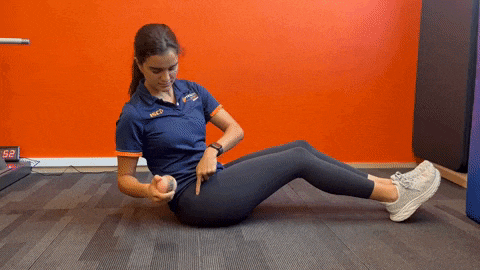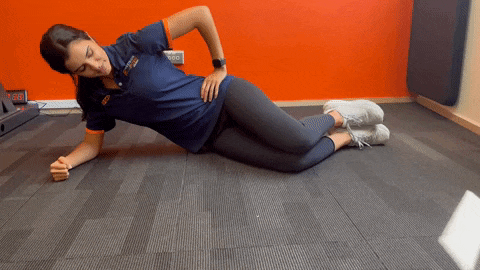In the clinic, we see a lot of people coming in with anterior knee pain (either sharp or achy) that is aggravated when they sit for prolonged periods, run, climb stairs, or squat.
After thorough assessment to rule out other knee injuries with similar presentations, this knee pain is commonly diagnosed as Patellofemoral Pain Syndrome (PFPS), also known as runner’s knee.
Despite its nickname, it is not only experienced by runners, and it can come on relatively quickly or slowly over time. Most commonly, PFPS will present as pain over or around the kneecap, but it can also cause pain in the back or side of the knee.

Relevant Anatomy
Before we can get into what PFPS is and its causes, it’s important to cover some basic knee anatomy.
The knee consists of two major joints:
- The tibiofemoral joint- between the tibia (shinbone) and the femur (thighbone)
- The patellofemoral joint- between the patella (kneecap) and the femur
PFPS involves the patellofemoral joint. The patella sits within the femoral groove and cartilage on both surfaces allows the patella to glide over the femoral groove.
The knee joints are surrounded by a synovial capsule containing synovial fluid which also contributes to the ability of these joints to glide easily.
Finally, there are bursae (small sacks of fluid) around the knee which ensure better gliding of the tendons and ligaments around the knee.
What Causes PFPS?
PFPS is often caused by a combination of different issues. One of the most common causes of PFPS is the orientation/ alignment of the patella. When the patella is orientated more towards one side, it can glide more to one side of the femoral groove and overload that surface. This overload can cause pain or discomfort in the joint.
There are many reasons this variance in orientation or alignment may occur. Muscle imbalances are a common cause. For example, if the quadricep muscle on the inside of your knee (vastus medialis) is weaker than the muscle on the outside of the knee (vastus lateralis), the stronger muscle will exert higher force and pull the kneecap more laterally causing an overload on the lateral part of the patellofemoral joint.
Other causes include but are not limited to hyperextension of the knee, rotation of the shin or thigh bone, flat feet, or weak hip abductors.
Home Exercises
As we covered above, there are many different factors that can cause PFPS, therefore, the treatment for this condition will vary between different people. However, below are some general exercises addressing the main affected muscle groups to get you started at home.

Wall Sit:
- Lean against a wall and go into a sitting position with your knees bent at 90 degrees
- Hold this position for 30-45 seconds to start. As it gets easier you can increase the time to 60 seconds
- If this position is too difficult or causes too much knee pain, move up the wall so that your knees are slightly more extended
TFL Trigger:
- Sitting on the ground, slightly bend your hip and knee
- Place the trigger ball between the front of your hip bone and the top of your thigh bone
- Lie down on your side on top of the ball. The more weight you put over the ball, the more pressure you will feel


Side-Lying Clams
- Lying on your side bend your knees and hips and make sure your hips are stacked on top of each other
- Lift the top knee up towards the ceiling without moving your hips backwards
- Repeat this movement 8-12 times
- If you’re able to do 12 reps easily, add an exercise band around your thighs just above your knees
These exercises aim to strengthen and release different muscle groups that commonly contribute to the development of PFPS.
If you find that your knee pain persists, book an appointment with your physiotherapist so that they can help you solve the cause of your knee pain and offer a personalised road to recovery.
This Article
Was written by one of our great Physio’s at Precision Physio Concord – Maddy Elazzi. To work with Maddy or any of our talented Precision Physio team members, please get in touch.
How Do I Book An Appointment?
We’re taking the health of our clients, members and staff very seriously and our preference would be for you to call to book an appointment so that we can make sure to explain our approach to keeping you safe. You can call any of these numbers to schedule a session:
- Precision Physio Concord: 02 9736 3950
- Precision Physio St Marys: 02 9623 2220
- Precision Physio Mt Druitt: 02 9188 2552
Online Consultations
Evolving with the current environment, we are also now offering online appointments, meaning that we can support anyone who is unable to leave their home. Sessions are done via our state of the art Telehealth system and as long as you have a laptop or tablet with an inbuilt camera, or a phone with camera, we can help!
To learn more about online consultations, please call us on any of the numbers listed above.